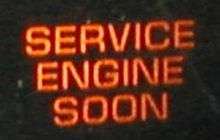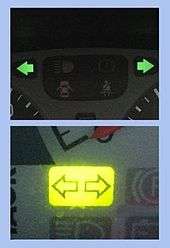Idiot light

A tell-tale (or idiot light, especially in North America[1]) is an indicator of the status or malfunction of a system within a motor vehicle. A tell-tale consists of a light bulb or an LED which lights up a symbol or text legend.
The "idiot light" terminology arises from popular frustration with automakers' use of tell-tales for crucial functions which could previously be monitored by gauges, so a troublesome condition could be detected and corrected early. Such early detection of problems with, for example, engine temperature or oil pressure or charging system operation is not possible via a tell-tale, which usually illuminates only once a fault has already occurred – thus providing no advance warnings or details of the malfunction's extent. The Hudson automobile company was the first to use lights instead of gauges for oil pressure and the voltmeter, starting in the mid-1930s.[2][3]
Regulation
Automotive tell-tales are regulated by automobile safety standards worldwide. In the United States, National Highway Traffic Safety Administration Federal Motor Vehicle Safety Standard 101 includes tell-tales in its specifications for vehicle controls and displays.[4] In Canada, the analogous Canada Motor Vehicle Safety Standard 101 applies.[5] In Europe and throughout most of the rest of the world, ECE Regulations specify various types of tell-tales.
Types
Different tell-tales can convey different kinds of information. One type lights or blinks to indicate a failure (as of oil pressure, engine temperature control, charging current, etc.); lighting and blinking indicate progression from warning to failure indication. Another type lights to alert the need for specific service after a certain amount of time or distance has elapsed (e.g., to change the oil). Another type lights to indicate a condition of readiness. A "closed-circuit tell-tale" lights to indicate a device or system that has been switched on, while an "operating tell-tale" lights to indicate a device or system which is operating correctly.[6]
Colour can also communicate information about the nature of the tell-tale. Typically, in modern vehicles, green means that something is on (e.g. a turn signal). Yellow or amber is a warning, but you can continue driving (e.g. a defroster, which can drain the battery if left on, or the check engine light). Red means that you cannot continue driving (e.g. oil pressure, parking brake, etc.) Many older vehicles used schemes which were specific to the manufacturer, e.g. some British Fords of the 1960's used amber for the turn-signal tell-tale and green for oil pressure warning, while many other makes of the same era used amber for oil pressure.
Vehicle running condition
Some tell-tales indicate whether critical vehicle systems are running and operating properly. To test the lamps, many tell-tales can illuminate when the vehicle ignition is turned on, but before the engine is started, in order to prove that they are working.
Oil pressure
The oil pressure tell-tale lights when engine oil pressure drops below a predetermined level. The light normally appears when the vehicle ignition is turned on, but the engine is not running, as it detects no oil pressure due to the oil pump not operating (the oil pump is powered off the crankshaft, so only operates when the engine is running). It normally turns off a few seconds after engine start as the oil pump starts working and building up oil pressure. This tell-tale can bear the legend oil or a pictogram of an oil can. Some cars illuminate the light red or yellow, depending on the action needed to be taken.[7]
Engine temperature
The engine temperature tell-tale is usually installed singly, but has less commonly been installed in pairs. A pair of lights indicate insufficient (cold, blue) and excessive (hot, red) engine temperature.[8] A single light usually indicates only an overheat condition in engine.
Malfunction indicator (check engine)

A "malfunction indicator lamp" (MIL) or "check engine light" (CEL) illuminates, usually in red, amber, or yellow, to indicate malfunction or service required in the computerized engine management system. It is found on the instrument console of most automobiles. In the United States, an MIL with specified functions is required by environmental protection regulations.[9]
On vehicles equipped with OBD-II, the light has two stages: it illuminates steadily to indicate a minor fault such as a loose gas cap or malfunction with the vehicle's emissions controls, and it flashes repeatedly when a severe misfire is detected to alert the driver the potential of severe engines or catalyst damages. The MIL can present a legend, such as check engine, power limited, engine, or service engine soon; or it also can present a pictogram of an engine.
Service interval
Some vehicles have a MIL illuminating predetermined distance intervals, without regard to actual condition or status of any system or device. Volvo, for example, used a light labeled lambda or Λ, "Lambda Sond" being another name for oxygen sensor. This was done to remind the driver to change the oxygen sensor.
Some vehicles were built by Chrysler between 1973 and 1990 and some Toyota-built vehicles have a similar mileage-indicator light presenting various legends such as check egr or maint reqd; once the indicated inspection or service is completed, the light can be reset and come on again after the next pre-determined distance has passed.
Honda uses a wrench symbol to indicate that an oil change or other regular maintenance is due.
Charging system
A tell-tale can be installed to indicate that the vehicle's alternator or generator is not properly charging the battery, which would eventually under this condition become discharged. The light normally appears when the vehicle ignition is turned on, but the engine is not running, as it detects that no power is coming from the alternator (the alternator is powered off the engine so only generates when the engine is running). It subsequently extinguishes as soon as the engine starts and the alternator starts generating electricity. This light presents a pictogram of a battery, or it presents the legend amp or batt or gen.
Trouble indicator
Some vehicles had a single indicator labeled trouble or engine; this was not a Check Engine Light, but a catch-all warning light to indicate trouble that was serious enough to portend an imminent breakdown. Early 1980s Fords, such as the LTD Crown Victoria, without the instrument option, had only this light, which indicated low oil pressure, overheating and carburetion problems without distinguishing among them. This usage of the "engine" light was discontinued in the mid-1980s to prevent confusion with the MIL.
Equipment status
Many tell-tales indicate that a device or system has been switched on, or is operating.
Lighting equipment

US, Canadian, and international European regulations require tell-tales to indicate to the driver that various vehicle lighting functions are operating. Such functions include the high beam headlamps, the turn signals, the daytime running lights, the front fog lamps, and the rear fog lamps. Also, in the case of a malfunction of turn signals, it is required for the driver to be notified by either clicking faster when turning on the malfunctioned turn signal, or not lighting up the tell-tale for the corresponding turn signal.
Defogger
Vehicles equipped with a backglass defogger have a tell-tale to indicate when the system is switched on and operating.
Brake
Many vehicles have a red tell-tale to indicate that the parking brake is engaged or that there is a fault with the vehicle's braking system.[7] This tell-tale in most cases bears the ISO symbols for a parking brake and for a braking system emergency. In the past, US regulations required this tell-tale to bear the legend brake.[10]
Vehicles with anti-lock braking system (ABS) have a lamp to indicate a detected failure.[7]
Other systems
As automobiles became increasingly complex, more dashboard indicator lights have been added for the status of safety and convenience systems. Lights can indicate many conditions including:
- Low fuel – Appears when vehicle's fuel tank is nearing empty. Usually shaped like a fuel pump, or a light next to the "E" on the fuel gauge.
- Glowplugs operating – wait to start (diesel engines) – Appears when the engine is switched on to indicate the engine glowplugs are operating, and the driver should wait for the light to extinguish before starting the engine. Usually shaped like a coiled wire.
- Driver or passenger seat-belt not buckled (sometimes with a buzzer) – Appears when the engine is switched and the driver's and/or passenger's seat belt is not buckled. A pressure sensor in the passenger seat prevents the passenger warning light from activating if the seat is unoccupied. Usually shaped like a person wearing a seat belt.[7]
- Traction control anti-skid system operative
- Low windshield washer fluid
- Air-bag system malfunction detected
- Water in fuel (diesel engines)
- Door open, or trunk lid open [7]
- Anti-theft alarm/engine immoblizer active
- Speed radar detected
- Automatic transmission fault
- Low tire pressure
- Modes of the heating/air conditioning system (defrost, recirculation, and others)
- Cruise control on[11]
- Autopilot/Self driving mode active
References
- ↑ "Idiot Light - Definition of idiot light by Merriam-Webster".
- ↑ "Popular Mechanics".
- ↑ "Directory Index: Hudson/1933_Hudson/1933_Hudson_Super-Six_Owners_Manual".
- ↑ "FDsys - Browse Code of Federal Regulations (Annual Edition)".
- ↑ Canada Motor Vehicle Safety Standard No. 101
- ↑ ECE R48, "Installation of lighting and light-signalling devices on motor vehicles"
- 1 2 3 4 5 Erjavec, Jack (2005). Automotive Technology. ISBN 1-4018-4831-1.
- ↑ "Popular Science".
- ↑ https://books.google.com/books?id=q8_vHlaJHVwC&pg=PA200&dq=Malfunction+indicator+light+OBD&hl=en&ei=h4j-TNSEFoiDOpaCvc4M&sa=X&oi=book_result&ct=result&resnum=1&ved=0CC0Q6AEwAA#v=onepage&q=Malfunction%20indicator%20light%20OBD&f=false Code of Federal Regulations CFR 40 ar{Part 86, retrieved 2010 Dec 7
- ↑ "Federal Register - Federal Motor Vehicle Safety Standards; Controls and Displays".
- ↑ "Cruise (Speed) Control Indicators".